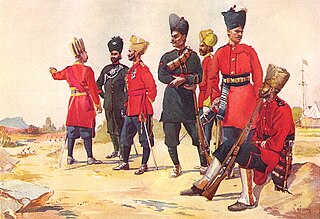Related Research Articles

The 123rd Outram's Rifles was an infantry regiment of the British Indian Army.
The 105th Regiment of Foot (Madras Light Infantry) was an infantry regiment of the British Army, raised by the Honourable East India Company in 1766. Under the Childers Reforms it amalgamated with the 51st (2nd Yorkshire West Riding) Regiment of Foot to form the King's Own Yorkshire Light Infantry.
The 134th Regiment of Foot was an infantry regiment of the British Army, created in 1794 and disbanded in 1796. The regiment was formed in Ireland by redesignating the newly raised 2nd Battalion of the 83rd Regiment of Foot, and did not leave Ireland before being disbanded in 1796.
The 129th Regiment of Foot was an infantry regiment of the British Army. It was created in 1794 and disbanded in 1796. The regiment was raised at Coventry, and was originally titled the Gentlemen of Coventry's Regiment of Foot, being retitled the 129th a few days later.
The 125th Regiment of Foot was an infantry regiment of the British Army, created in 1794 and disbanded in 1796. It was raised at Stamford, Lincolnshire, under the colonelcy of Newton Treen.
The 123rd Regiment of Foot (Loyal Lincolnshire) was an infantry regiment of the British Army, formed in 1794 and disbanded in 1796; it took its title from the 100th Foot, disbanded in 1785.
The 100th Regiment of Foot, or the Loyal Lincolnshire Regiment, was an infantry regiment of the British Army, formed in 1780 and disbanded in 1785. The Loyal Lincolnshire Regiment was reformed in 1794 as the 123rd Regiment of Foot and was again disbanded in 1796.
The 122nd Regiment of Foot was an infantry regiment of the British Army, formed in 1794 and disbanded in 1796.
The 121st Regiment of Foot was an infantry regiment of the British Army, formed in 1794 and disbanded in 1796.
The 121st Regiment of Foot was an infantry regiment of the British Army, formed in 1762 and disbanded in 1764.
The 119th Regiment of Foot was an infantry regiment of the British Army, formed in 1794 and disbanded in 1796.

The 119th Regiment of Foot was an infantry regiment of the British Army, formed in 1761 by the regimentation of independent companies and disbanded in 1763.
The 115th Regiment of Foot (Royal Scotch Lowlanders) was an infantry regiment of the British Army from 1761 to 1763.
The 114th Regiment of Foot was an infantry regiment of the British Army from 1794 to 1795. It was raised in April 1794 and was disbanded the following year.
The 114th Regiment of Foot (Royal Highlander Volunteers) was an infantry regiment of the British Army from 1761 to 1763.It was raised in October 1761, by Sir Allan MacLean of Torloisk. He was commissioned lieutenant in the 60th Foot Royal Americans at the beginning of the Seven Years' War and was severely wounded at Ticonderoga in 1758. He was then given one of the four NY Independent Companies until he returned to Scotland where he raised the 114th Maclean's Highlanders, or the Royal Highland Volunteers, as their Major Commandant. The regiment was disbanded in 1763.
The 110th Regiment of Foot (Queen's Royal Musqueteers) was an infantry regiment of the British Army from 1761 to 1763.
The 108th Regiment of Foot was an infantry regiment of the British Army from 1761 to 1763. It was raised in October 1761 from a cadre of the 31st Regiment of Foot, and was disbanded in 1763.
The 104th Regiment of Foot was a regiment of the British Army, raised by the Honourable East India Company in 1765. Under the Childers Reforms it amalgamated with the 101st Regiment of Foot to form the Royal Munster Fusiliers.
The 111th Tank Division was a Tank division of the Soviet Union's Red Army and after 1946, the Soviet Army. The division was formed in the summer of 1941 in the Soviet Far East from the tank regiment of a motorized division that had been reorganized into a motor rifle division, and had thus lost its tank regiment. The division never fought in combat and was in reserve during the Soviet invasion of Manchuria. Postwar, the division continued its garrison duty in the Far East. The 111th was renumbered as the 16th Tank Division in 1955.
References
- ↑ "123rd Regiment of Foot". regiments.org. Archived from the original on 7 October 2007.